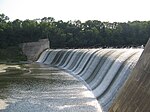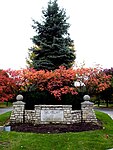Quarry Trails Metro Park

Quarry Trails Metro Park is a 220-acre (89 ha) metropolitan park in Columbus, Ohio, owned and operated by Columbus and Franklin County Metro Parks. The park opened on November 30, 2021, as Central Ohio's 20th metro park. Portions of the park remained under construction, although 200 acres opened, including a 25-foot waterfall, trails, boardwalks, and a zipline.The park still borders active portions of the Marble Cliff Quarry; other portions were sold for housing and mixed-use developments. Marble Cliff was formerly the largest quarry in the United States, the source for limestone used in the Ohio Statehouse and Ohio Stadium, and was the workplace for many Italian immigrants who settled in the surrounding area.Around March 2022, construction of a rock-climbing wall began at the park, to be 160 feet tall and about 1/2-mile wide, utilizing stones leftover from the quarry site. Designed by Via Ferrata Works, it will be the first urban via ferrata in the United States.
Excerpt from the Wikipedia article Quarry Trails Metro Park (License: CC BY-SA 3.0, Authors, Images).Quarry Trails Metro Park
Old Dublin Road, Columbus
Geographical coordinates (GPS) Address Nearby Places Show on map
Geographical coordinates (GPS)
| Latitude | Longitude |
|---|---|
| N 40.003 ° | E -83.091 ° |
Address
Old Dublin Road
Old Dublin Road
43221 Columbus
Ohio, United States
Open on Google Maps








